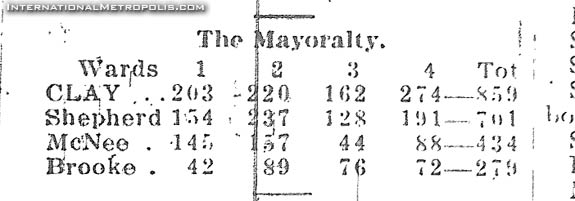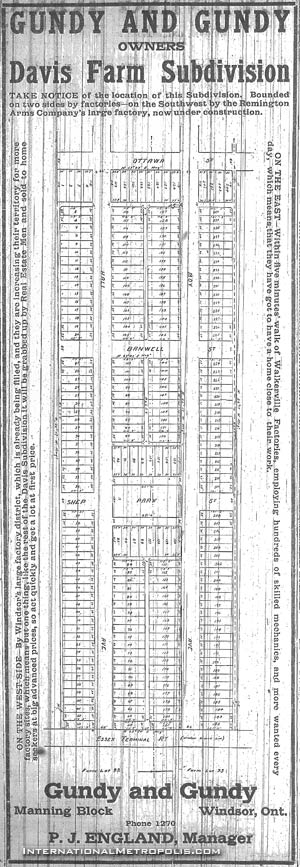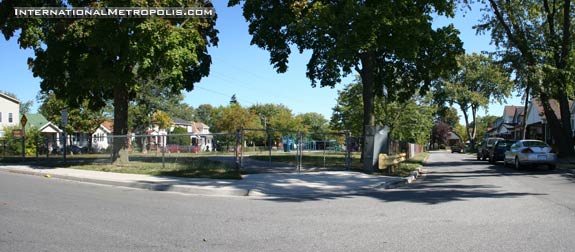Before today’s post kicks off, there’s a small explanation to spit out…
I’m going to apologize in advance for today’s post… It’s a bit longer than usual, but it came out of the other day’s post about the Davis Farm/Moy Hall. It’s related to that post, but in doing some research for this post, I kind of ran into another story that needed to be told. The information that does exist out on the internets is sadly not accurate. That wrong information can be found on the city website, and it’s not really shocking to me that a City that has proven over the decades how little it cares about it’s past would have the facts wrong. After all, what would you expect. I managed to did up all this information in a couple of hours, so I can only imagine how busy everyone is at City Hall to not be able to do the same…
Today’s post was going to be about a park, and it still is… kind of. There’s just a bit more of the story to tell first.

Today’s story kicks off on December 30, 1912. James H. Shepherd is the sitting Mayor of Windsor, coming towards the end of his first term [*NOTE* – This is the first of several mistakes to be corrected today. The City’s “Previous Mayors” section lists him incorrectly as James H. Shepard]. I also have a feeling that he’s the namesake of Shepherd Street. On a side note, one block south of Shepherd is Hanna Street. The mayor prior to Shepherd was John W. Hanna. A bit too much of a coincidence for me. Especially given that these streets would have been laid out during this time…
Ok, a bit off topic there, but back to the story we go… December 20, 1912 was nomination day at City Hall. City Clerk Steven Lusted, opened the nominations at 10:00 am, and when they closed at 11:00 am (yes, nominations for public office elections were only accepted for one hour!), there were six candidates for mayor. According to the article in the Evening Record, it was the “Biggest field of entries that can be recalled”.
The candidates were:
Sitting mayor James Shepherd
Archibald McNee
Henry Clay
T.W. Brooke
J.H. McConnell
Samuel K. Peck
Apparently all were expected to run, except for Peck, he was a bit of a surprise entry into the Mayor’s Race.

Clay seemed to be a bit of a rabble rouser. Reading through the quotes attributed to each candidate at the public forum following the nomination, Clay was the only one to go after the sitting mayor. Each candidate was given five minutes to address the crowd that had gathered. Mayor Shepherd was up first, and talked about the things that the city had accomplished during the last year. A new park, a new dock, hydro electric power and the establishment of the factory district (along McDougall).
The other candidates followed… McConnell talked about the cost of bringing hydro electric power… McNee then spoke about how he had always been interested in municipal politics but never had any desire to run for office while active in business, but now that he was retired he had the time to do it. He then spoke about the topics of the day as well… Brooke was then up, talking about the factory district and the new park. He then tossed a jab at Mr. McNee:
There was much laughter when Mr. Brooke paid his respects to Mr. McNee, saying, “He is seeking election now after his time of usefulness as a business man is gone.”
“That’s a three-base hit,” remarked J.H. McConnell
Henry Clay then had the floor, stating he was a business man, but he had the time to devote to the job. He then tossed a jab at McNee as well, asking if he now had all this free time, then how come he only attended 12 of the 22 school board meetings during the year (McNee was a trustee of the School Board along with Clay).
He then went after Mayor Shepherd’s claim that “there had been no criticism of the 1912 council”, he pointed out several examples as well as “…an indictment against the city on the unsanitary condition of the police quarters in the City Hall.”
“I say it is a disgrace that this city should be indicted”, declared Mr. Clay. “Criticism? Isn’t that enough. What more do they want? I voted for Mayor Shepherd for the unexpired term and thought he could fill Mr. Hanna’s shoes, but they were too big for him.”
I wish we had citizens today at the local level who were willing to call out, and run against sitting incumbents like Clay did.

Election day was January 6, 1913. Yes, the time between the nominations and the election was eight days.
Residents saw the headline above in the Evening Record on January 7, 1913.
BARRISTER HENRY CLAY WINDSOR’S NEXT MAYOR
Somewhere over those eight days between nominations and elections, both J.H. McConnell & Samuel K. Peck dropped out of the race, leaving four candidates on the ballot.

Clay won by 158 votes, defeating incumbent Mayor Shepherd by a vote total of 859 to 701.
So who was the new mayor? He was born in Wallacetown, Ontario, and according to his “biography” that ran in the paper following his election, he had a sharp wit, and liked lawn bowling. Shortly after being called to the bar in 1888, he moved to Amherstburg, where he “practiced law, was the editor of a weekly newspaper and served in the municipal council.”
He moved to Windsor about 1907 and opened a law firm here. The first time he ran for public office in Windsor was in 1912, when he was elected a school trustee. He resigned that post in December 1912 in order to run for mayor.

While Clay had carried the election, the games weren’t done…
The above appeared in the Evening Record February 7, 1913. Some political opponents tried to get Mayor Clay disqualified based on the residency requirements of 1912.
The contention is that Mayor Clay qualified on a leasehold that he does not possess, the petition setting forth that he is only a monthly tenant of the premises in which he lives.
The law requires a yearly lease on property with an assessed value of not less than $2,000. Mayor Clay declares he leases property valued at $3,500.
According to the Mayor, he didn’t seem very concerned:
The mayor states that he is not worrying over the outcome of the case, which he says is the work of his political opponents, more for spite than anything else.
He must have been cleared as he stayed as mayor, and was re-elected in 1914 defeating alderman and future mayor Charles Tuscon. [His re-election is error number 2 & 3 in today’s list of City Information errors. The City’s “Previous Mayors” section , doesn’t list him as Mayor for 1914, it lists Frederick L. Howell. Fred Howell, took over as mayor (he was the ward 1 alderman) when Mayor Clay stepped down. As for the 3rd error, we’ll get to that soon…]

The news above broke Monday, July 13, 1914. Mayor Clay was resigning as mayor to take on a job as local registrar of the Supreme Court and clerk of the High Court, replacing Francis Cleary (Cleary was Mayor of Windsor from 1883-1885, and the father of Edmund Cleary, who was the namesake of the Guest house and Auditorium).
According to the report, the council had the option to hold a new election or to appoint one of the sitting councilors as acting mayor to the end of the year. It would appear that that’s what happed as Alderman Fred Howell, alderman for Ward 1 took over and finished the term. Despite not being elected Mayor, the City’s listing gives him full credit as Mayor for 1914, when the listing should also reference Mayor Clay, who was the one who was actually elected.

Henry Clay died June 2, 1926, and that edition of the Border Cities Star featured the headline:
HENRY CLAY, FORMER MAYOR, DEAD
He died at 67, following an illness of several months, and an unsuccessful surgery at Hotel-Dieu Hospital.
One of the most interesting things that jumped out to me in his obituary was that he was an early advocate for the St. Lawrence Seaway. He was the chairman of a meeting that took place at Windsor City hall on January 30, 1914, at which “representatives of the cities and towns located along the Great Lakes and the St. Lawrence formulated the first concerted resolution addressed to the government on the matter”. The object of the meeting was “to consider the the best means of securing action that would result in the construction of a deep waterway from the lakes to the Atlantic Ocean, and emphasized the fact that such a channel would to a large extent relieve the congestion of traffic which was an annual occurrence.”
Later that year WWI broke out, and the public interest in the St. Lawrence plan lapsed. The St. Lawrence plan was finally approved in 1954, and the seaway opened in 1959.
Clay left one son Alger, in Regina, his other son Talbot, died in 1924 from Tuberculosis that was contracted during WWI. Henry Clay was buried in Windsor Grove.
Despite Clay’s standing as a prominent citizen, and front page news about his death, he doesn’t even rate a mention in Neil Morrison’s “Garden Gateway To Canada”, which covers 100 years of Windsor and Essex county history, from 1854-1954.
Now that the 1500 word essay on Henry Clay is done, I can get to what was going to be the simple subject of today’s post… However, I thought the back story was a little bit interesting, and I thought you the reader may enjoy it.

So today’s post was supposed to be about Clay Park, one of the “features” of the sub-division of the Davis Farm south of Ottawa Street.
Ironically Clay Park (named after Mayor Clay), sits in the middle and disrupts Shepherd Street (which I assume is named after Mayor James Shepherd, who was defeated by Clay in 1913).
So even to this day Clay disrupts Shepherd. 🙂

Above is an ad from 1913, advertising the subdivision, offered for sale by Gundy & Gundy and the park is clearly visible.

Which brings us to the final set of errors. This is the listing in the City of Windsor Parks History, put out by the department of Parks & Recreation a few years ago:
Clay Park
Commonly known as: Clay Park
Former/other names: none
Location: between Moy and Hall Avenues on the Shepherd Street boulevard
Property acquired: 1915
Acreage: 0.69
Official designation: Neighbourhood park
The site of Clay Park was bequeathed to Windsor in 1915 by the Davis family, who had previously
farmed on this area. In 1917, the property was placed under the jurisdiction of the Parks Board and
formally named Clay Park, after former Windsor Mayor Henry Clay, whose term in office lasted
one year (1913).
Although baseball, softball and football games were popular activities at the park in its early years,
such sports were banned in 1959, ostensibly because of the park’s small size and because of the
frequent and excessive property damage suffered by area residents.
Recent improvements by the Department of Parks and Recreation include the installation of new
playground equipment, new pathways and fencing. Clay Park is now a greatly improved facility.
A few facts that are wrong… As shown with this post and the previous, the Davis Farm was sold in 1912, to land developers who subdivided the property and laid out the park. The Davis family was out of the picture by the time the park was created.
Mayor Clay as we have seen wasn’t a one term Mayor.
With the park being laid out in 1913 (later advertisements tout the park, and the lots around it went up for sale March 29, 1913).
My gut feeling tells me the park was named in 1913 after the sitting mayor.

Either way, here’s the history of a little neighbourhood quirk, how it came to be, and who it’s named after.
There are names all over the City on parks, and buildings, with the namesakes long forgotten, so it’s interesting every once in a while to uncover who things are named after.
Have a good weekend everyone, the Streetcar show opens to the public tomorrow (maybe even this afternoon), with the “official” opening on the 16th… Details to follow…


Great post today Andrew! The back story was very interesting and the back story appreciated.
Thanks Andrew, my kids play in that park all the time, we even cut it during the strike. Now we know.
Cheers.
Ha! What you say? The City of Windsor has their history wrong? No! Not Windsor.
I agree with you that this city doesn’t give a rat’s fart about it’s own history and yet here it is with some of the most richest history in Canada and we are still trying to identify what type of city we want to be. It is a disgrace and the blame goes to the many councils over the years for neglecting what is truly a fascinating past; a past which most cities would crave to have.
Nice work. Good research.
Great piece of history – thanks for digging it up and posting. Historical facts tend to become distorted with the passage of time, and it doesn’t just happen in our Windsor. But Windsor has you to research and correct.
I always wondered how that park came to be smack in the middle of a cross street. Bet it was a great selling point for the properies around it.
Excellent post, and I appreciate your research and corrections!
Hopefully the city will correct their error’s, and pay more attention to respecting the people that helped build our city.
kls.
I live right near this park too. Thanks Keith for cutting it, my son really appreciated being able to use it.
And thanks to you too Andrew, for another informative post.
Very interesting and informative Andrew.
Looking forward to Streetcars too.
Thank you for the history lesson, quoting of incorrect facts is a real pet peeve of mine, we see it all over the place, papers TV movies etc. and once it gets repeated enough times and reaches a largest enough audience it starts getting quoted as fact.
Great article, Andrew : )
What really jumps out at me is the fact that people actually used to play baseball in that park!! Its a tad small for that, and all those windows of the houses surrounding Clay Park must have taken quite a beating haha.
Love the local history under our noses : )
Great work, Andrew, very interesting. Thanks!
very interesting, dont worry about being long, the longer the better.
its always amazing to me how you come to find these facts. excellant work!!
as always, love this site.
I always thought, that park felt out of place. Great essay.
I loved reading what your ‘digging’ brought up. It’s the little-known stories that fill in the big gaps of history! Thank you, a job well-done!
My Mom grew up on Moy Ave. just north of Clay Park in the early 1940s. She recalls going to a wading pool there and being kept home during outbreaks of polio. Remnants of the wading pool were still in place in the 1960s when I played there as a child.